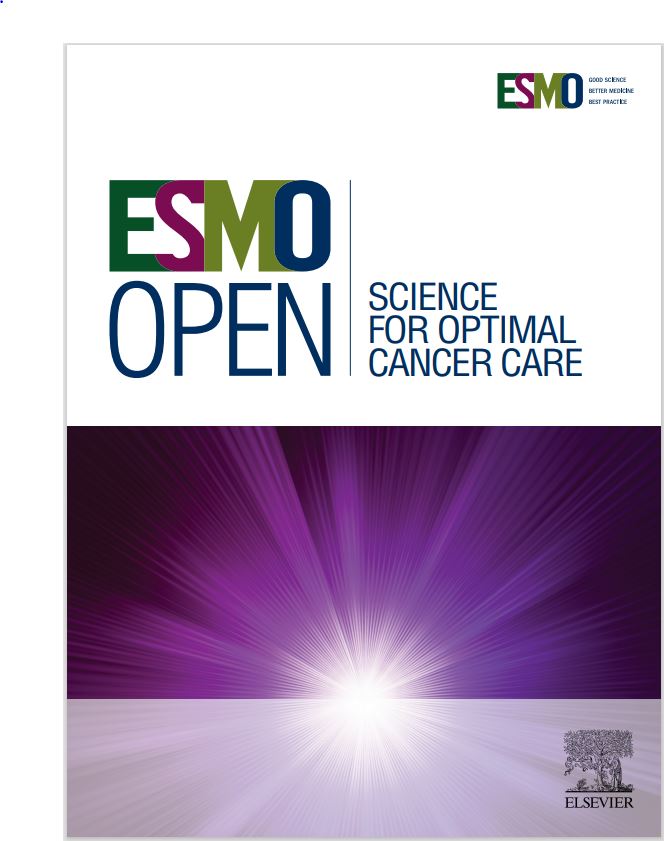尼拉帕尼在复发性卵巢癌维持治疗中的暴露-反应关系:法国GINECO-NiQoLe研究的辅助分析
IF 7.1
2区 医学
Q1 ONCOLOGY
引用次数: 0
摘要
背景:药代动力学的个体间差异可能影响尼拉帕尼治疗铂敏感复发性卵巢癌(ROC)患者的临床结果。我们的目的是研究尼拉帕尼在49例多中心IV期NiQoLe研究的ROC患者中的药代动力学-药效学(PK-PD)关系。材料和方法在PK-PD分析中分析了治疗开始后第8天(D8)和90天(D90)的稳态谷浓度(Cmin,ss),包括治疗前3个月的早期剂量限制性毒性(DLT)、自我报告的不良事件[不良事件通用术语标准(PRO-CTCAE)的患者报告结局版本]和无进展生存期(PFS)。采用Logistic回归和Cox比例风险模型分别确定PFS的毒性危险因素和预测因素。结果39例(80%)患者起始剂量为200mg /d。19例患者(39%)经历了早期DLT。在多变量分析中,与起始剂量(OR 0.44, 95% CI 0.04-4.76, P = 0.50)相比,第四个四分位数(Q4) Cmin,ss在D8(≥686 ng/ml)时被确定为早期DLT的独立危险因素[比值比(OR) 27.92, 95%可信区间(CI) 1.99-392.53, P = 0.014]。高Cmin, D8时ss也与自我报告的≥2级不良事件相关,包括恶心(P = 0.03)和疲劳(P = 0.02)。在单因素分析中,PFS与200 mg起始剂量无关[风险比(HR) 1.25, 95% CI 0.59-2.62, P = 0.57],也与Cmin无关(风险比1.03,95% CI 0.90-1.19, P = 0.65)。第4季度和第1-第3季度Cmin的PFS无差异,第8[174天(95% CI 120天-未达到)vs . 242天(95% CI 183-490天);Hr 1.15, 95% ci 0.57-2.36, p = 0.69]。减少剂量的患者的中位PFS与保持起始剂量的患者一致[分别为197天(95% CI 166天-未达到)和207天(95% CI 176-469天);log-rank P值= 0.29]。结论:D8 (Cmin,ss≥686 ng/ml)时血浆暴露增加与DLT早期发病和患者报告的不良事件的高风险相关,而PFS方面没有获得疗效。早期血浆药物监测可能有助于在维持期接受ROC治疗的患者预防尼拉帕尼毒性。本文章由计算机程序翻译,如有差异,请以英文原文为准。
Exposure–response relationship of niraparib in maintenance therapy for recurrent ovarian cancer: ancillary analysis of the French GINECO–NiQoLe study
Background
Interindividual variability in pharmacokinetics may influence clinical outcomes of niraparib in patients with platinum-sensitive recurrent ovarian cancer (ROC). We aimed to investigate the pharmacokinetic–pharmacodynamic (PK–PD) relationship of niraparib in 49 patients with ROC from the multicenter phase IV NiQoLe study.
Materials and methods
Steady-state trough concentrations (Cmin,ss) on days 8 (D8) and 90 (D90) after treatment initiation were analyzed in the PK–PD analysis in regard to early dose-limiting toxicity (DLT) during the first 3 months of treatment, self-reported adverse events [Patient-Reported Outcome version of the Common Terminology Criteria for Adverse Events (PRO-CTCAE)], and progression-free survival (PFS). Logistic regression and Cox proportional hazards models were used to identify risk factors of toxicity and predictors of PFS, respectively.
Results
The starting dose was 200 mg/day in 39 patients (80%). Nineteen patients (39%) experienced early DLT. In multivariable analysis, the fourth quartile (Q4) of Cmin,ss at D8 (≥686 ng/ml) was identified as an independent risk factor for early DLT [odds ratio (OR) 27.92, 95% confidence interval (CI) 1.99-392.53, P = 0.014] in contrast to the starting dose (OR 0.44, 95% CI 0.04-4.76, P = 0.50). High Cmin,ss at D8 was also associated with grade ≥2 self-reported adverse events, including nausea (P = 0.03) and fatigue (P = 0.02). In univariate analysis, PFS was associated neither with the 200-mg starting dose [hazard ratio (HR) 1.25, 95% CI 0.59-2.62, P = 0.57] nor with Cmin,ss at D8 (HR 1.03, 95% CI 0.90-1.19, P = 0.65). No difference in PFS was observed between Q4 and Q1-Q3 for Cmin,ss at D8 [174 days (95% CI 120 days-not reached) versus 242 days (95% CI 183-490 days), respectively; HR 1.15, 95% CI 0.57-2.36, P = 0.69]. Median PFS in patients who had a dose reduction was consistent with that of patients who remained at the starting dose [197 days (95% CI 166 days-not reached) versus 207 days (95% CI 176-469 days), respectively; log-rank P value = 0.29].
Conclusions
Increased plasma exposure at D8 (Cmin,ss ≥686 ng/ml) was associated with a higher risk of early DLT onset and patient-reported outcomes adverse events, without gain of efficacy in regard to PFS. Early plasma drug monitoring may be useful to prevent niraparib toxicity in patients with ROC treated in the maintenance phase.
求助全文
通过发布文献求助,成功后即可免费获取论文全文。
去求助
来源期刊

ESMO Open
Medicine-Oncology
CiteScore
11.70
自引率
2.70%
发文量
255
审稿时长
10 weeks
期刊介绍:
ESMO Open is the online-only, open access journal of the European Society for Medical Oncology (ESMO). It is a peer-reviewed publication dedicated to sharing high-quality medical research and educational materials from various fields of oncology. The journal specifically focuses on showcasing innovative clinical and translational cancer research.
ESMO Open aims to publish a wide range of research articles covering all aspects of oncology, including experimental studies, translational research, diagnostic advancements, and therapeutic approaches. The content of the journal includes original research articles, insightful reviews, thought-provoking editorials, and correspondence. Moreover, the journal warmly welcomes the submission of phase I trials and meta-analyses. It also showcases reviews from significant ESMO conferences and meetings, as well as publishes important position statements on behalf of ESMO.
Overall, ESMO Open offers a platform for scientists, clinicians, and researchers in the field of oncology to share their valuable insights and contribute to advancing the understanding and treatment of cancer. The journal serves as a source of up-to-date information and fosters collaboration within the oncology community.
 求助内容:
求助内容: 应助结果提醒方式:
应助结果提醒方式:


